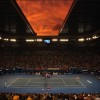By Randy Walker
@TennisPublisher
The retractable roof in tennis is now 25 years old.
It was on January 11, 1988 when the current site of the Australian Open tennis championships – then called the Australian National Tennis Centre at Flinders Park – opened its doors for the first day of championship play, featuring its first-of-its kind-in-tennis retractable roof over its center court stadium.
The move to the new facility, that cost $60 million at the time, catapulted the Australian Open into a new level of prominence. After years of barely being considered a Grand Slam tournament at the small and cramped facility at the Kooyong Tennis Club, its less-than-world-class quality grass courts, and its non-player friendly late December competition dates, the tournament vaulted into a modern era. The new venue with its new retractable roof, as well as the move to a hard-court surface and its new January competition dates, made the Australian Open the most progressive of the majors. It was 12 years later, in 2000, that the tournament added another stadium with a retractable roof, the HiSense Arena, giving the tournament the distinction of having two retractable roofs before any other major tournament had one.
It wasn’t until Wimbledon debuted its retractable roof in 2009 that the Australian Open was joined by any of the major tournaments in this category. In 2009, the French Open announced that a redesign of the Roland Garros facility would include a roof, although the plans for its debut have now been delayed until at least 2018. The US Open, mired in five straight years of rain-delayed Monday finals, has said it is not if they will have a roof over one of its stadiums, but when, without revealing any time table or plan as of yet. In the mean time, the Australian Open plans to have its Margaret Court Arena fitted with a retractable roof in time for the 2015 Australian Open, giving the now named Melbourne Park facility three roofed stadiums, joining the now named Rod Laver Arena and the HiSense Arena.
The following is my summary of the first day of tennis at the new Australian Open venue from January 11, 1988 from my book ON THIS DAY IN TENNIS HISTORY, available for $19.95 at www.TennisHistoryBook.com. The 2013 Australian Open begins Monday, January 14.
Jan. 11, 1988 – Play begins at the Australian Open at the new $60 million Australian National Tennis Center at Flinders Park in Melbourne with American qualifier Wendy Wood winning the first match played in the new stadium court, later to be known as Rod Laver Arena, beating No. 14 seed Dianne Balestrat of Australia. Wood, 23, from Lexington, Mass., defeats the top-ranked Australian woman 6-2, 4-6, 8-6, registering her first professional match victory after playing only two previous WTA Tour-level events. “I’m very nervous now. I’m not used to these kind of situations,” says Wood, whose father Wilbur Wood was a standout pitcher for the Chicago White Sox in the 1960s. “I knew I was going to be nervous, but I figured she had more reason to be nervous than me.” Balestrat, 31, and an Australian Open finalist in 1977, says she has some difficulty adapting to the court – the synthetic Rebound Ace hard court surface – used for the for the first time at the Australian Open after a switch from grass courts. Pat Cash, the No. 4 seeded Australian and reigning Wimbledon champion, plays the second stadium court match and is greeted with boos and shouts from a group of anti-apartheid protestors who, in protest of Cash playing in South Africa the previous year, also throw black tennis balls on the court before being escorted from the stadium. Cash is fined $500 for swearing at a linesman in the final game of his 7-5, 6-1, 6-4 win over 20-year-old Thomas Muster of Austria. Also on the day, Yannick Noah of France, the No. 5 seed, staves off two match points before overcoming Roger Smith of the Bahamas 6-7, 5-7, 6-4, 6-2, 16-14 in 4 hours, 51 minutes, the longest-recorded match at the time at the Australian Open. Says Noah, who saves the match points in the 16th game of the final set, “After I saved the match points, I felt much stronger.”

